The HTC One M9 Review: Part 1
by Joshua Ho on March 22, 2015 7:00 PM EST- Posted in
- Smartphones
- HTC
- Qualcomm
- Mobile
- Snapdragon 810
- One M9
System Performance: Snapdragon 810
We've been able to test Snapdragon 810 before, but it was only in the context of Qualcomm’s developer platform tablets and phablets, which have a higher possible TDP than shipping devices, and generally doesn’t have any need for battery life as these devices usually spend all of their time plugged into a charger. Thus, the One M9 represents our first experience with a Snapdragon 810 device with shipping software and hardware. HTC noted during the review process that our devices were running non-final software, and we received an OTA update that significantly changed the thermal throttling characteristics of the device, but this seems to have only affected performance in situations where the SoC was nearing maximum acceptable skin temperatures as performance in these benchmarks were relatively unchanged.
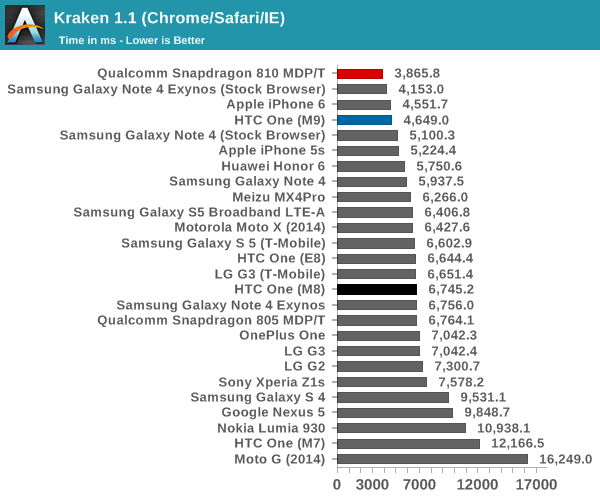
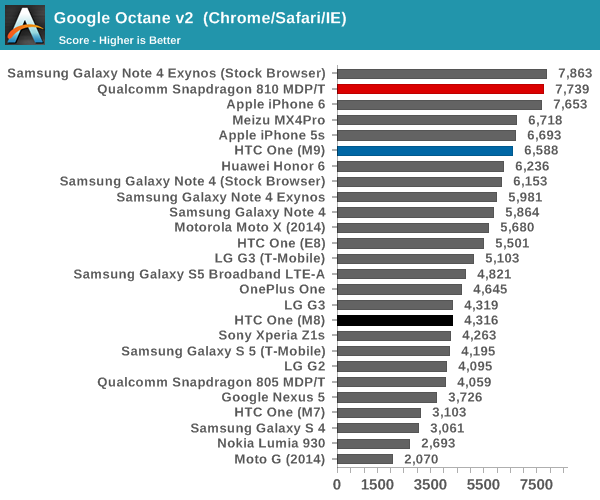

In our first few browser tests, we can see that the One M9 posts dramatically lower performance than the Snapdragon 810 MDP/T, which seems rather strange. However, using CPUBurn to try and load just a single thread reveals that without HTC’s CPU cheats, it’s basically impossible to get the A57 cluster beyond 1.5 to 1.6 GHz. It's important to emphasize that this isn't new behavior, as this was present on pre-release software as well, which means that HTC didn't do this at the last minute.
For those that are unfamiliar with how HTC's CPU cheats work, HTC continues to rely on some level of benchmark detection, and it seems that when a benchmark is detected it enables a "High Performance" mode in the developer settings with no option to disable this mode. It's possible to work around this mode by using benchmarks that evade such detection mechanisms (and we do), but it's also possible manually toggle this mode on and off if a benchmark isn't detected. This benchmark mode appears to relax throttling constraints, but more obviously it enables one to go from a maximum of 1.6 GHz to the rated 2.0 GHz of the Snapdragon 810 for extended periods of time. However, even in this mode we can see that a sustained load of a single thread on the A57 cluster will cause the cluster to throttle to 1.7 GHz in this mode, while without this mode enabled we see that a single thread will eventually cause the A57 cluster to clock around 1 to 1.2 GHz. If the normal governor does allow the SoC to reach 1.9 GHz, I can't really perceive the amount of time that it does reach such a speed.
The most concerning result is WebXPRT, which is a bursty workload that runs over a few minutes, which suggests that we’re already seeing thermal throttling in the M9.

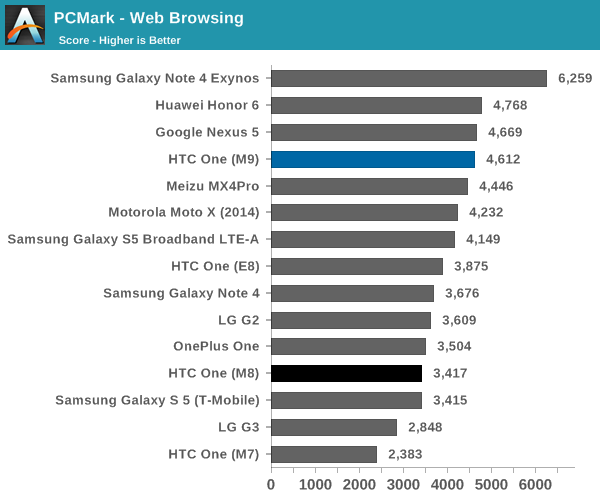
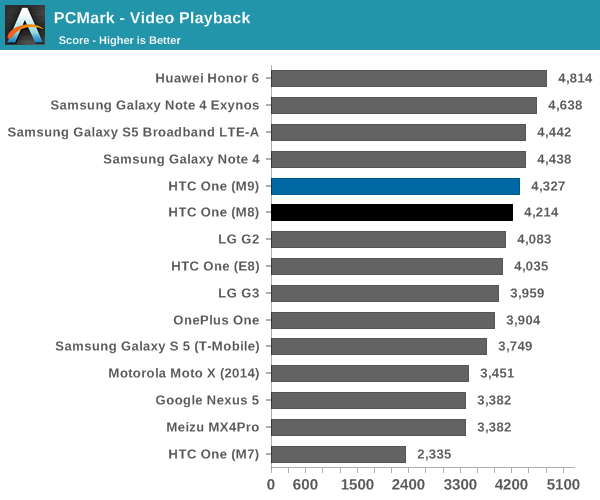
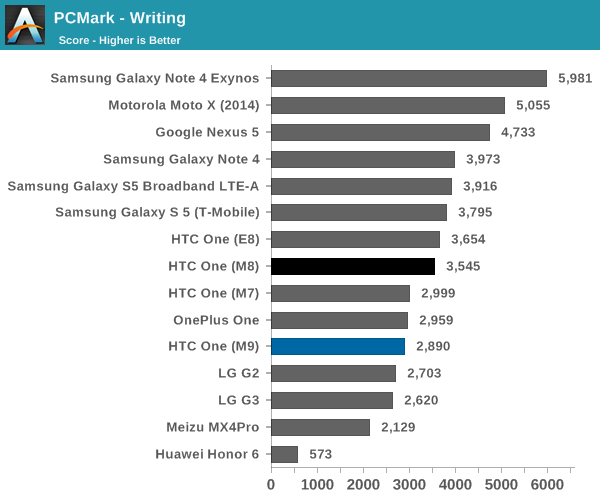
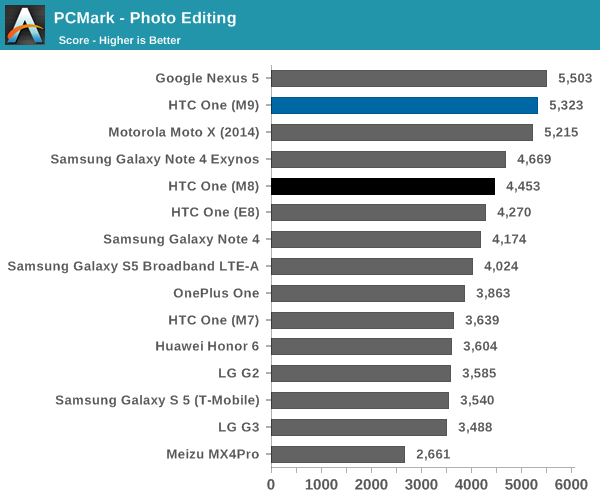
In PCMark, which is a benchmark that tends to focus strongly on race to sleep scenarios, we can see that the Snapdragon 810 appears to significantly trail behind the Exynos 5433, which is on a similar process node. It's hard to say whether this is due to the scheduler configuration or differences in the physical design of the SoC, but at any rate this is another concerning performance from the SoC of the One M9.
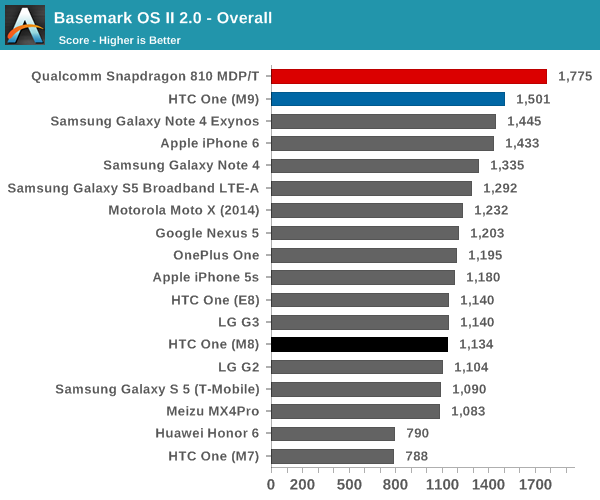

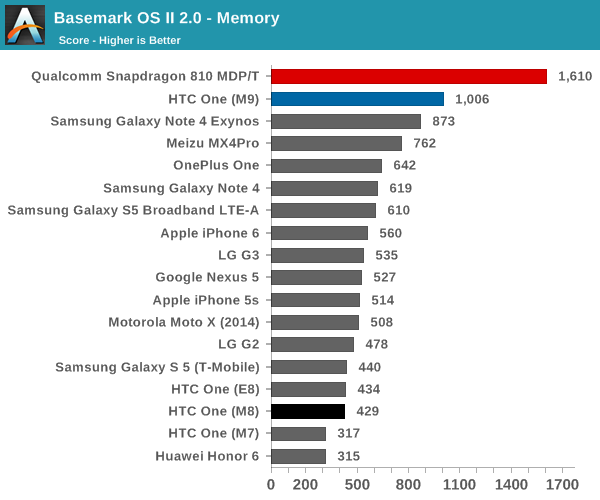
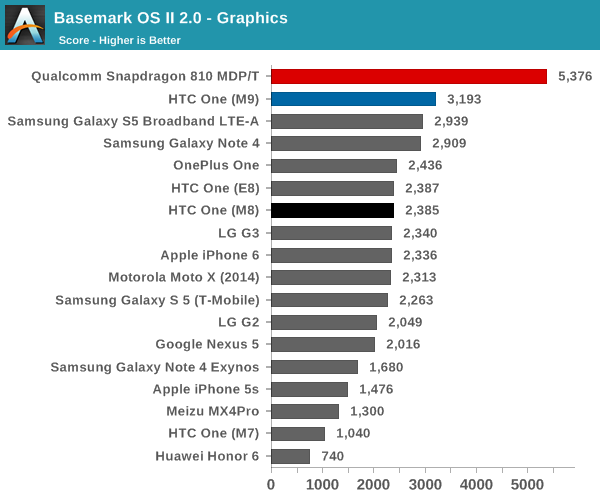
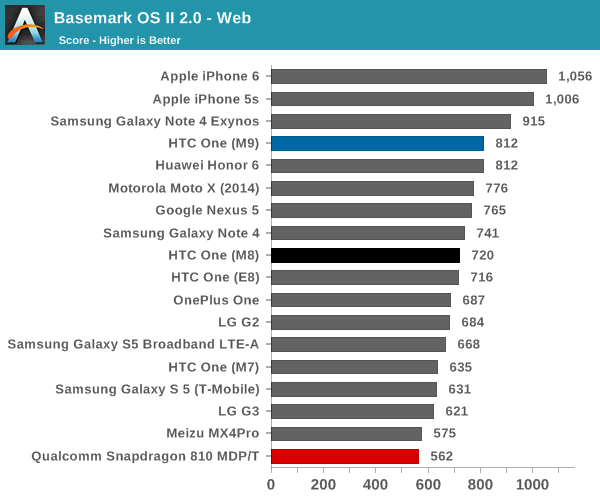
Moving on to the general system performance tests, we see that the M9 delivers a reasonable improvement in performance over the M8, but most of the difference seems to come from the GPU and storage performance rather than anything else that was tested. Overall, the Snapdragon 810 really isn’t off to the best start in any test we’ve thrown at it so far. To see if Snapdragon 810 has any redeeming features we’ll look at GPU performance next.


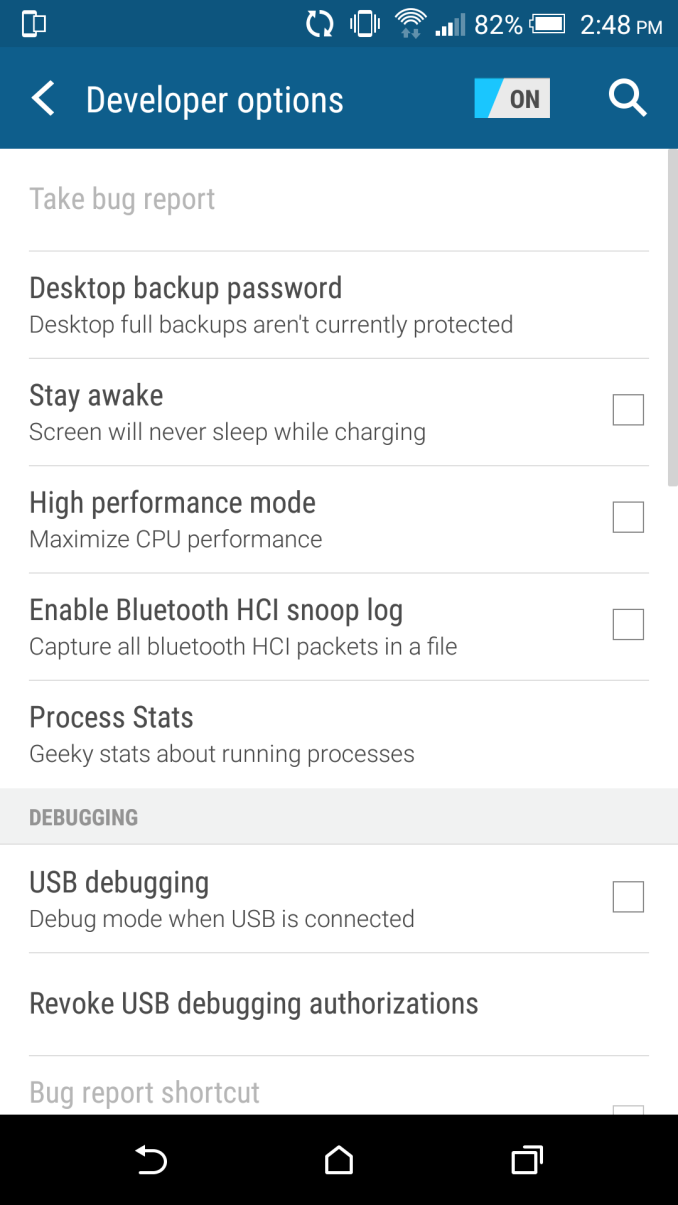








132 Comments
View All Comments
fokka - Monday, March 23, 2015 - link
charge time is measured using the included 1.5A charger, as far as i can tell. this makes sense for most people, but i'd still like to see if a good quick charge 2.0 enabled charger can improve charging time. please?tipoo - Monday, March 23, 2015 - link
Lol. Watts already include time.mchart - Sunday, March 22, 2015 - link
My first entry to Android was the M8 and while I loved Android - I found the M8 wasn't all that great. It had a great spec sheet, but real world battery life and standby time to my 5s was pretty bad. The camera on the M8 was also really bad so I'm glad they fixed that. Sense blows. The worst part about sense is how it locks out any customization of the lock screen. The only widget sense allows is it's own on that lock screen. Horrible. I really hated that.So while I'm sure the m9 is better, it really only seems to fix the camera problem. It doesn't fix the inherent build quality issues I found with the m8s design, and the excessive size of the device.
I haven't given up on Android though. I recently got my Z3 Compact in the mail and it's perfect. It has outstanding real world battery life, has a better physical design, has the top end hardware, and Sony doesn't ruin Android with touch wiz/sense type of crap install all that much.
fokka - Monday, March 23, 2015 - link
you seem to have quite unique complaints about the m8, since most points you disliked are things other users and reviews applauded htc for. build, battery, sense... all this are generally considered strengths of the m8.also, as we see, the m9 doesn't really improve on many aspects of the m8, even the camera seems to be as sub par es ever, if we can believe first reviews.
i agree that the z3 compact is a very nice phone, but its hardware isn't truly better than the m8 neither. camera and battery life yes, but the rest is mostly the same or up to personal opinion.
V900 - Monday, March 23, 2015 - link
Well battery and camera are a pretty big part of the experience, no?The Z3 compact at least has one thing going for it, the size. It seems to be the only quality Android phone that isn't right around 5 inches. If I would ever switch back to Android from iOS, it would definitely be my first choice...
Yesumanu - Sunday, March 22, 2015 - link
To wrap things up:- Lackluster screen when compared to M8 and competition
- Generally improved software but either Sense 7 is unoptimised or it's the S810
- Snapdragon 810 dissapointing performance when compared to older Snapdragons
- Throttling
- Battery life is worse with same resolution and size screen, lower brightness, newer SoC and bigger battery
- The camera is better in theory
So basically they took the One M8 improved the camera and software, relocated the power button but at the same time the screen, battery life, performance, and temperatures suffered quite a bit. How do they expect people to buy this phone? Many were already dissapointed when they heard that M9 is only going to be a minimal upgrade, but to see that it's worse that the M8?
hung2900 - Sunday, March 22, 2015 - link
You forgot cheating in benchmarking also.sonny73n - Monday, March 23, 2015 - link
HTC is just like most of other companies - they're just cranking up the specs without really improving anything. They've lost their senses in how to make a great device. Sad.warezme - Monday, March 23, 2015 - link
Truly sad, I too have an M7. The size is better than the new M8 and M9, the screen is better and I could get it in black. I don't want another me too gold/silver phone.fokka - Monday, March 23, 2015 - link
they should just stop with those fugly gold/champagne/rose colors already. since when is it ok to offer a high end phone in silver/gold dual tone, instead of a pure and simple black?